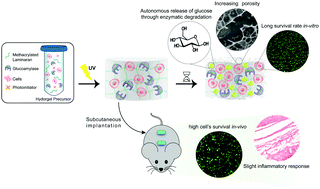Self-glucose feeding hydrogels by enzyme empowered degradation for 3D cell culture†
Abstract
Hydrogels have been used in combination with cells for several biomedical and biotechnological applications. Nevertheless, the use of bulk hydrogels has exhibited severe limitations in diffusion of oxygen, nutrients, and metabolites. Here, a support for cell culture is reported where glucose is generated in situ by the own hydrogel degradation, allowing cell survival and function while promoting tissue growth. For this purpose, laminaran (or laminarin)-based hydrogels were fabricated, immobilizing the adequate enzymes to obtain structural platforms for 3D cell culture and providing glucose feeding for metabolic activity of cells through polysaccharide degradation. We demonstrate that tumor A549 cells and human mesenchymal stem cells (hMSCs) can use the glucose resultant from the hydrogel degradation to survive and grow in non-added glucose cell culture medium. Additionally, in vivo biocompatibility and biodegradability of laminaran-based hydrogels were explored for the first time. The self-feeding hydrogels exhibited high potential in cell survival compared to native cell-laden laminaran hydrogels over two weeks of sub-cutaneous implantation. Such bioscaffolds with enzyme-empowered degradation capacity can be applied in diverse biotechnological contexts such as tissue regeneration devices, biofactories, disease models, and cell delivery systems.

- This article is part of the themed collection: Materials Horizons 10th anniversary regional spotlight collection: Europe


 Please wait while we load your content...
Please wait while we load your content...